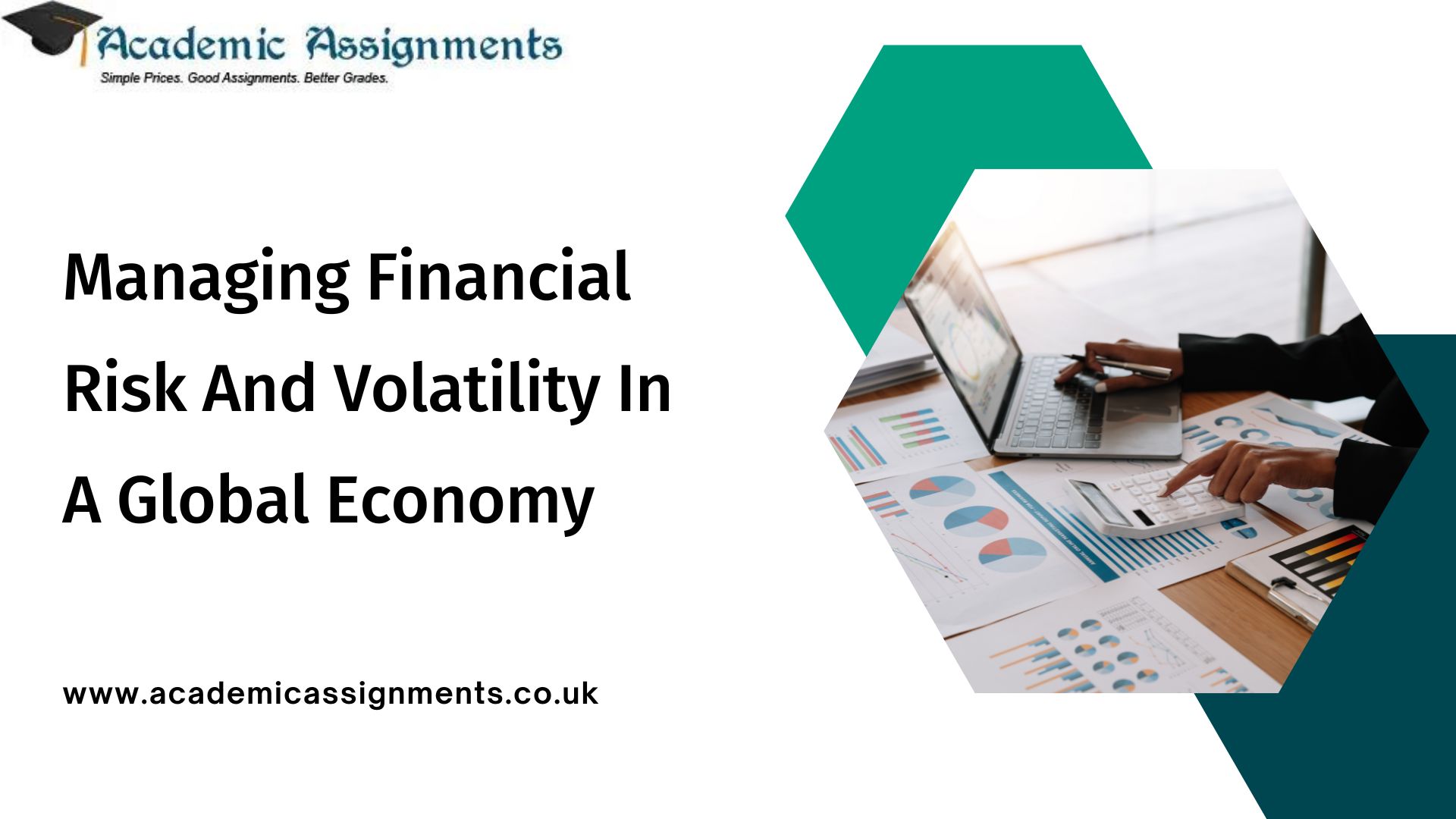Managing Financial Risk And Volatility In A Global Economy
Every business firm has some risks, which means that if this situation occurs in any of the organisations, then it may cause the business firm to have undesired effects and outcomes. Managing risks can be done easily with the help of several tools and techniques that help recognise, measure and manage risks. Different organisations utilise various techniques for identifying and mitigating investment risks to have benefits and increase returns from the earnings and investments from business activities by lowering the cash flows, enhancing the company’s value, mitigating the volatility of earnings and managing the operating and financing cost. When focusing on investment, it is important to focus on creating more returns as investment is done to get some returns from the initial investment. For instance, asset managers mainly get involved in competition depending on the ability to generate returns and generally try to surpass the benchmark. The association between return and risk is a basic concept of investment which retailers overlook. Most retailers (investors) believe that if they earn more returns than the set benchmark, then they generate value.
Global Concerns
As per the reports of a survey in 2021, novel risks are emerging rapidly, and the landscape of risk is growing difficult, fast-paced and volatile. The question regarding the importance of financial risk (giving importance to energy sectors and utilities) and operational risks (showing difficulties for the platforms and software sector) came to light. The disruption of the supply chain and a significant boost in the remote location work during the health crisis worsened the operational risks. Further, the financial risks infuriate the credit risk concerns because of economic uncertainty. In addition to this, cyberattacks have also risen, which can shut down important business systems. Still, if business firms are doing everything to strengthen their organisations operational resiliency, there exists a chance for disasters to occur. So, business leaders must make robust and flexible plans to resolve problems and respond appropriately when disasters are likely to happen. According to an article on financial risks and climate change, risks associated with climate change are increasingly considered in making policy and the essential regulatory requirements, such as damaging infrastructure, land and property. These are some of the potential exposures which show inferences into the financial sector. Additionally, other published articles suggest that climate change can release financially and extremely disruptive events. Also, the bankers cannot save the world from these events. The major focus has been shifted towards climate risk, but it still takes up several major risks. These are operational risk, market risk, liquidity risk and credit risk. Moreover, investment risks, breaks and security in business continuity may help boost the challenges list, mainly faced by the financial and capital markets. Factors of Environmental, Social and Governance (ESG) are occupying the centre stage in the appearance of sustainability risk. These types of risks negatively affect the reputation and assets of the bank and the bank’s earnings and financial condition.
How Can One Manage Financial Risk?
To manage financial risk, regulators must identify businesses’ requirements to represent data in large numbers and generate progressive reports accurately to support the durability of banks and financial institutions. They also use software usage in the maintenance of financial risk management. The advantages of using this software are relevancy and accuracy, automation, real-time recording, updating information and securing data processing, which allows institutions and businesses to walk along with the changes. Additionally, several software for risk management strategies aid in establishing appropriate risk controls: the larger the result of the risk, the more rigorous the controls must be applied.
Read Also: Sustainable Finance: Integrating Environmental and Social Factors in Business Decision Making
Advantages Of Financial Risk Management
- Efficient control and coordination of business processes
- Managing inundated data
- Improving performance measurement
- Better knowledge of sources of profit
- Developing a strategy for risk management
Software for control and risk management consists of several facets of the risk management processes, from recognising the risk to assessing and monitoring its mitigation. Some of the features of risk management software consist of the following-
- Representing it visually
- Techniques for evaluation
- Activities to control
- Analytics
- Reporting
- Observing and monitoring the risk
Organisations and business firms must contact third parties who are experts in mitigating financial risk management.
Government Offsetting Financial Risk
Financial risk is the governments potential to lose control of the monetary policy of the economy and be unable to manage inflation and back out on the issues of debt and bonds. The government issues debt as notes and bonds to build bridges and infrastructures, fund wars, and pay for their daily operations. The governments of several countries which failed to pay the issued debt involves the government of Venezuela, Argentina, Russia and Greece. These nations make investors and stakeholders suffer from loss because of financial risk when the organisations delay their debt repayment, or they pay less than what was agreed upon.
Effect of Financial Risks On Markets
There are many forms of financial risks which are related to financial markets. Also, there are many conditions which affect the financial markets. At the time of the global financial crisis in 2007 to 2008, the important sectors of businesses started struggling, which affected the monetary well-being of the whole marketplace in the nation. At the time of this crisis, businesses started shutting down, and investors started losing their fortunes, making the government rethink the country’s monetary policy. However, there were other reasons as well which affected the market. Volatility comes with uncertainty in the assets of the market regarding the fair value. As a statistical measure of financial risk, it shows the stakeholder`s confidence, which matches the market returns with the exact valuation of the assets used by individuals and the marketplace. Implied volatility is indicated by a percentage that shows whether the market is bearish or bullish. The implied volatility indicates that the market is rising or declining based on investments. Moreover, equity risk or volatility becomes the reason for sudden price swings in the stock shares.
Modifications and defaults in the interest rate of markets also have the capability of posing a financial risk. When the issuers of business firms or companies do not pay their harming investors and obligations of debt, then defaults in the bond or debt market occur. Continuous modification in the market’s interest rate pushes the individual securities, making them unprofitable for stakeholders and investors. This further forces them to pay reduced debt securities or face negative returns. Asset-backed risk is an opportunity for asset-backed securities, which consist of large and different loan types which become volatile when the fundamental securities change their value. Asset-backed risk sub-categories involve the early paying of debt by the borrower, ultimately finishing the income stream from repayments and making significant modifications in the interest rate.
Market Volatility
Several factors are responsible for the rising market volatility, including geopolitical tensions, unexpected news, investor sentiment and economic events. These factors are responsible for triggering price fluctuations significantly and creating risks and opportunities for investors. Indicators, including inflation and interest rates, play an important role in influencing market volatility. Changing the interest rate directly impacts the investment decisions, borrowing costs and the economic activity as a whole. Rising interest rates lead to slow growth of the economy, reduced consumer spending and high borrowing costs for firms. While the reduced interest rate fosters the economy’s expansion, it may also increase inflation concerns. Fluctuating inflation rates affect consumer spending patterns, corporate profitability and purchasing power.
Effect on portfolios
The effect of economic indicators varies on the investment portfolios based on investment strategy and asset allocation. An increasing interest rate tends to negatively impact fixed-income securities when the prices of the bond decrease because of higher rates. Still, cyclical and financial stock sectors benefit from the increased rates because of the improvised prospects of the business and enhanced lending profitability. Inflation destroys the actual value of the returns on fixed-income investments. Investors must consider the class of assets that performed well during inflationary periods, like real estate, commodities and equities. Moreover, several sectors, including utilities and consumer staples, are less likely to be affected by the effects of inflation because of the important nature of their services and products.
Handling and Managing Volatility With Purpose: Strategies For Impact Investing
The goal of impact investing is to create pragmatic environmental and social consequences along with financial returns, which play an important role in navigating volatile markets. It mainly focuses on sectors like sustainable agriculture, education, healthcare and renewable energy, which are inclined to exhibit resilience when the economy is facing downturns. Investments in organisations that practice robust environmental, social and governance (ESG) aid in lowering the risk and providing stability to the portfolio when the organisation is facing difficulty.
Protection Against Market Volatility: Diversified Portfolios
A diversified portfolio has a mixed asset class, which protects against fighting market volatility. Investors can lower the effects of market fluctuations on the overall portfolio by assigning investments across real estate, equities, alternative investments and fixed income. Various classes of assets are inclined to represent different performance characteristics, allowing investors to represent possible profits in one region while reducing losses in another. Furthermore, diversification can be attained by examining different industries, geographies and sectors under each asset class. This further aids in lowering the concentration risk and boosting the exposure to various market drivers while enhancing portfolio resilience.
Conclusion
Financial risk occurs on its own across organisations, governments, markets and individuals. Organisations deal with the chances to earn benefits and make gains for the opportunity in which they face disastrous conditions or lose their money. They can utilise various analysis methods to forecast risk and make proper plans so that the financial risks can be mitigated or reduced. While volatility in the financial markets becomes unavoidable, investors must be ready to navigate the uncertainties and associated risks. Investors can make informed decisions and develop strategies by having proper knowledge of factors contributing to market volatility to create returns on the adjusted risks. Establishing a diverse portfolio, executing techniques for active risk management and embracing long-term perspectives aid investors in standing against fluctuating markets and capturing possible opportunities.
Moreover, it provides a captivating path for aligning financial objectives by generating pragmatic environmental and social consequences. When the market condition seems challenging, organisations need to stay disciplined, take advice from professionals, make evaluations continuously and adjust investment strategies. This helps investors position themselves for achieving success and attaining the company’s long-term financial goals.
Author Bio: Mark Edmonds, a recognized master at Academic Assignments work in finance, brings an abundance of information and experience to the field. With a sharp spotlight on financial risk management and global market dynamics, Mark has been a dependable wellspring of guidance for students seeking first rate finance assignment help. Through extensive research and practical insights, he endeavors to give a deeper understanding of exploring financial risks and volatility in the present complex global economy. Mark is focused on engaging students with the mastery required for financial success.

 Blogs
Blogs





